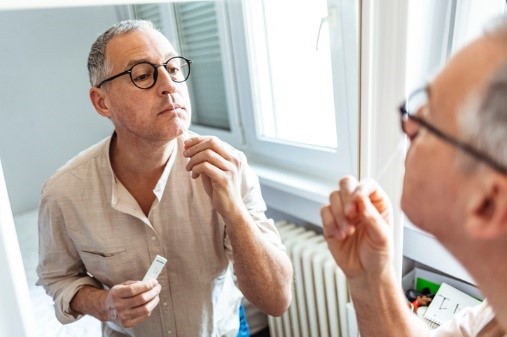COVID-19 Testing at Home
What does a positive result mean for you?
 In recent weeks, the number of COVID-19 cases broke records in the United States. This pandemic peak comes as the delta and omicron variants spread. You may need to know if you have the COVID-19 virus, but don't want to go in person or wait in long lines. This may be when you need to use a self-test.
In recent weeks, the number of COVID-19 cases broke records in the United States. This pandemic peak comes as the delta and omicron variants spread. You may need to know if you have the COVID-19 virus, but don't want to go in person or wait in long lines. This may be when you need to use a self-test.
Is self-testing for you?
You may have COVID-19 even if you don’t have symptoms and haven’t been exposed to someone with the virus. Consider using a self-test before and 1-3 days after traveling or gathering indoors with people (for more than 1 hour) whose vaccination status you don’t know. This is important before gathering with unvaccinated children, older individuals, immunocompromised individuals, or those at risk of severe disease.
Getting an at-home test
Testing at home might be easier than waiting in line. COVID-19 tests are available online, in pharmacies, and even in retail stores. Before buying a test, make sure it has the FDA’s stamp of approval. In late January, the federal government is preparing to make them available for ordering online for free. You can get free tests from https://www.covidtests.gov/.
To perform the test at home
Wash your hands with soap and water for at least 20 seconds. Open the box and carefully follow the instructions included with the self-test to collect your own nasal specimen and to run the test itself. If you don’t collect the specimens and run the test as directed, your test results may be incorrect. This video walks you through the entire process.
What do positive results mean?
A positive test means you likely have COVID-19, and you should isolate. You should visit the CDC’s isolation calculator to see how long. Wear a well-fitted mask for ten whole days any time you’re around others inside your home or in public. Don’t go to places where you’re unable to wear a mask. Send a Secure Message to your doctor before ending your isolation. If you have trouble breathing, high fever, or severe medical conditions that reduce your immune system, please contact your doctor and get additional instructions. You can also do a symptom review on the CDC website for a symptom self-checker and follow instructions on when to seek emergency medical attention.
A negative test shows you may not be infected. But a negative result doesn’t rule it out. Repeating the test over two days or serial tests will increase the confidence that your result is accurate. For more help, you can watch this video on How to Interpret Self-Tests. If your result shows ‘Invalid’ or ‘Error’, and you have further questions, please contact your provider and schedule a laboratory test with your VA medical center.
Update your health record
When you get your Self-Test result, upload it to My HealtheVet. In a few simple steps, you’ll be able to keep all your health information in one place. Sign in and visit Self-Entered Tests and add the requested information. This is for your own records, and it cannot be shared with anyone unless you give it to them. Please also note the result of home testing (Self Entered Information) is not part of the official record and will not appear in your laboratory testing result section in your medical record.
Please vote in our unscientific poll. All responses are anonymous.
Read More
Self-Testing (CDC)
Get Your VA COVID-19 Test Results Online
At-Home COVID-19 Testing: Upload Your Results
Updated January 25, 2022



